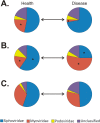Altered oral viral ecology in association with periodontal disease
- PMID: 24846382
- PMCID: PMC4030452
- DOI: 10.1128/mBio.01133-14
Altered oral viral ecology in association with periodontal disease
Abstract
The human oral cavity is home to a large and diverse community of viruses that have yet to be characterized in patients with periodontal disease. We recruited and sampled saliva and oral biofilm from a cohort of humans either periodontally healthy or with mild or significant periodontal disease to discern whether there are differences in viral communities that reflect their oral health status. We found communities of viruses inhabiting saliva and the subgingival and supragingival biofilms of each subject that were composed largely of bacteriophage. While there were homologous viruses common to different subjects and biogeographic sites, for most of the subjects, virome compositions were significantly associated with the oral sites from which they were derived. The largest distinctions between virome compositions were found when comparing the subgingival and supragingival biofilms to those of planktonic saliva. Differences in virome composition were significantly associated with oral health status for both subgingival and supragingival biofilm viruses but not for salivary viruses. Among the differences identified in virome compositions was a significant expansion of myoviruses in subgingival biofilm, suggesting that periodontal disease favors lytic phage. We also characterized the bacterial communities in each subject at each biogeographic site by using the V3 hypervariable segment of the 16S rRNA and did not identify distinctions between oral health and disease similar to those found in viral communities. The significantly altered ecology of viruses of oral biofilm in subjects with periodontal disease compared to that of relatively periodontally healthy ones suggests that viruses may serve as useful indicators of oral health status.
Importance: Little is known about the role or the constituents of viruses as members of the human microbiome. We investigated the composition of human oral viral communities in a group of relatively periodontally healthy subjects or significant periodontitis to determine whether health status may be associated with differences in viruses. We found that most of the viruses present were predators of bacteria. The viruses inhabiting dental plaque were significantly different on the basis of oral health status, while those present in saliva were not. Dental plaque viruses in periodontitis were predicted to be significantly more likely to kill their bacterial hosts than those found in healthy mouths. Because oral diseases such as periodontitis have been shown to have altered bacterial communities, we believe that viruses and their role as drivers of ecosystem diversity are important contributors to the human oral microbiome in health and disease states.
Copyright © 2014 Ly et al.
Figures





References
-
- Willner D, Furlan M, Schmieder R, Grasis JA, Pride DT, Relman DA, Angly FE, McDole T, Mariella RP, Jr, Rohwer F, Haynes M. 2011. Metagenomic detection of phage-encoded platelet-binding factors in the human oral cavity. Proc. Natl. Acad. Sci. U. S. A. 108(Suppl 1):4547–4553. 10.1073/pnas.1000089107 - DOI - PMC - PubMed
-
- Foulongne V, Sauvage V, Hebert C, Dereure O, Cheval J, Gouilh MA, Pariente K, Segondy M, Burguière A, Manuguerra JC, Caro V, Eloit M. 2012. Human skin microbiota: high diversity of DNA viruses identified on the human skin by high throughput sequencing. PLoS One 7:e38499. 10.1371/journal.pone.0038499 - DOI - PMC - PubMed
Publication types
MeSH terms
Substances
Grants and funding
LinkOut - more resources
Full Text Sources
Other Literature Sources
